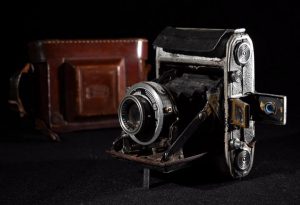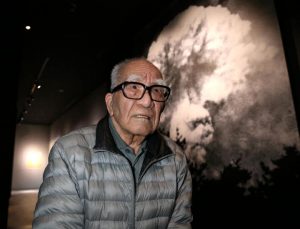Striving to fill voids in Hiroshima, evidence of victims remains—Records of A-bombing disaster: Seiso Yamada, former staff writer, donates camera that captured mushroom cloud photo two minutes after A-bombing to Chugoku Shimbun
Apr. 10, 2022
by Miho Kuwajima, Staff Writer
Seiso Yamada, 93, a resident of the town of Fuchu-cho in Hiroshima Prefecture who took a photograph of the mushroom cloud shortly after the atomic bomb was dropped, has donated the camera he used to the Chugoku Shimbun. Mr. Yamada is thought to have snapped the camera’s shutter about two minutes after the explosion to take the photo, which is thought to have been the earliest of any taken of the A-bomb mushroom cloud from ground level.
Mr. Yamada’s camera is called the Semi Sport, a folding, bellows-type model measuring 12 centimeters by 8 centimeters that was sold starting in 1940 by the Fujimoto Camera Mfg. Co. (now Kenko Tokina Corporation), located in Osaka City. He was a 17-year old junior high school student in Japan’s night-school system and, at the same time, worked part-time for the Chugoku Shimbun. He saw the blood red cloud near the entrance of Mikumari Gorge (part of the town of Fuchu-cho) near his home, located about six kilometers from the hypocenter. He remarked, “What’s that? It’s beautiful,” and immediately took the photo of the cloud using the camera he had taken with him.
The photo received notice for the first time in 1946, while the post-war press code (censorship) was still being administered by the General Headquarters of the Allied Forces (GHQ). The Yukan Hiroshima, a local evening newspaper, on July 6, introduced the photo with the captions, “Documentary photo of the century” and “Shortly after detonation, the moment the atomic bomb opened up into the shape of the mushroom.” The photo has been enlarged to dimensions measuring 3.8 meters by 2.7 meters and is now displayed near the entrance of the main building of the Hiroshima Peace Memorial Museum. Unlike the aerial photos of the cloud taken by the U.S. military, which had conducted the atomic bombing, the photo serves as a symbol of the view that citizens had under the mushroom cloud.
After the war ended, Mr. Yamada worked as a staff writer for the Chugoku Shimbun. Yasuhisa Yamada, 65, his oldest son, said that his father had once had shown him the Semi Sport, introducing it as the camera he used to take the mushroom cloud photo, but afterward the camera went missing. Nine years ago, when cleaning up belongings of family members who had passed away, they found the camera.
Mr. Yamada began to think of donating his camera after being interviewed by the Chugoku Shimbun and recounting his experiences in the atomic bombing at the end of last year. Regarding his mushroom cloud photo, he said, “I would like people in 100 years’ time to see this photo and know it was the atomic bomb dropped on Hiroshima.” The camera shows signs of deterioration, such as peeling of its surface layer. After he spoke with his oldest daughter, Aya, 56, and other relatives, he made up his mind based on the idea that he would feel more relieved to place the camera under the care of others.
Kotaro Takahashi, 50, grandson of the late Kenzo Takahashi, former president of Fujimoto Camera who was engaged in manufacture of the Semi Sport, said, “I have heard the model was developed for the general public based on Germany’s high-end cameras. I was surprised to know that a camera produced by my grandfather had captured that historic moment.” The Chugoku Shimbun will carefully archive the camera used for recording the tragedy and display it publicly when commemorating the company’s 130th anniversary this year.
(Originally published on April 10, 2022)
Seiso Yamada, 93, a resident of the town of Fuchu-cho in Hiroshima Prefecture who took a photograph of the mushroom cloud shortly after the atomic bomb was dropped, has donated the camera he used to the Chugoku Shimbun. Mr. Yamada is thought to have snapped the camera’s shutter about two minutes after the explosion to take the photo, which is thought to have been the earliest of any taken of the A-bomb mushroom cloud from ground level.
Mr. Yamada’s camera is called the Semi Sport, a folding, bellows-type model measuring 12 centimeters by 8 centimeters that was sold starting in 1940 by the Fujimoto Camera Mfg. Co. (now Kenko Tokina Corporation), located in Osaka City. He was a 17-year old junior high school student in Japan’s night-school system and, at the same time, worked part-time for the Chugoku Shimbun. He saw the blood red cloud near the entrance of Mikumari Gorge (part of the town of Fuchu-cho) near his home, located about six kilometers from the hypocenter. He remarked, “What’s that? It’s beautiful,” and immediately took the photo of the cloud using the camera he had taken with him.
The photo received notice for the first time in 1946, while the post-war press code (censorship) was still being administered by the General Headquarters of the Allied Forces (GHQ). The Yukan Hiroshima, a local evening newspaper, on July 6, introduced the photo with the captions, “Documentary photo of the century” and “Shortly after detonation, the moment the atomic bomb opened up into the shape of the mushroom.” The photo has been enlarged to dimensions measuring 3.8 meters by 2.7 meters and is now displayed near the entrance of the main building of the Hiroshima Peace Memorial Museum. Unlike the aerial photos of the cloud taken by the U.S. military, which had conducted the atomic bombing, the photo serves as a symbol of the view that citizens had under the mushroom cloud.
After the war ended, Mr. Yamada worked as a staff writer for the Chugoku Shimbun. Yasuhisa Yamada, 65, his oldest son, said that his father had once had shown him the Semi Sport, introducing it as the camera he used to take the mushroom cloud photo, but afterward the camera went missing. Nine years ago, when cleaning up belongings of family members who had passed away, they found the camera.
Mr. Yamada began to think of donating his camera after being interviewed by the Chugoku Shimbun and recounting his experiences in the atomic bombing at the end of last year. Regarding his mushroom cloud photo, he said, “I would like people in 100 years’ time to see this photo and know it was the atomic bomb dropped on Hiroshima.” The camera shows signs of deterioration, such as peeling of its surface layer. After he spoke with his oldest daughter, Aya, 56, and other relatives, he made up his mind based on the idea that he would feel more relieved to place the camera under the care of others.
Kotaro Takahashi, 50, grandson of the late Kenzo Takahashi, former president of Fujimoto Camera who was engaged in manufacture of the Semi Sport, said, “I have heard the model was developed for the general public based on Germany’s high-end cameras. I was surprised to know that a camera produced by my grandfather had captured that historic moment.” The Chugoku Shimbun will carefully archive the camera used for recording the tragedy and display it publicly when commemorating the company’s 130th anniversary this year.
(Originally published on April 10, 2022)









